CBD Marketing: Navigate Regulations & Stand Out in a Crowded Market
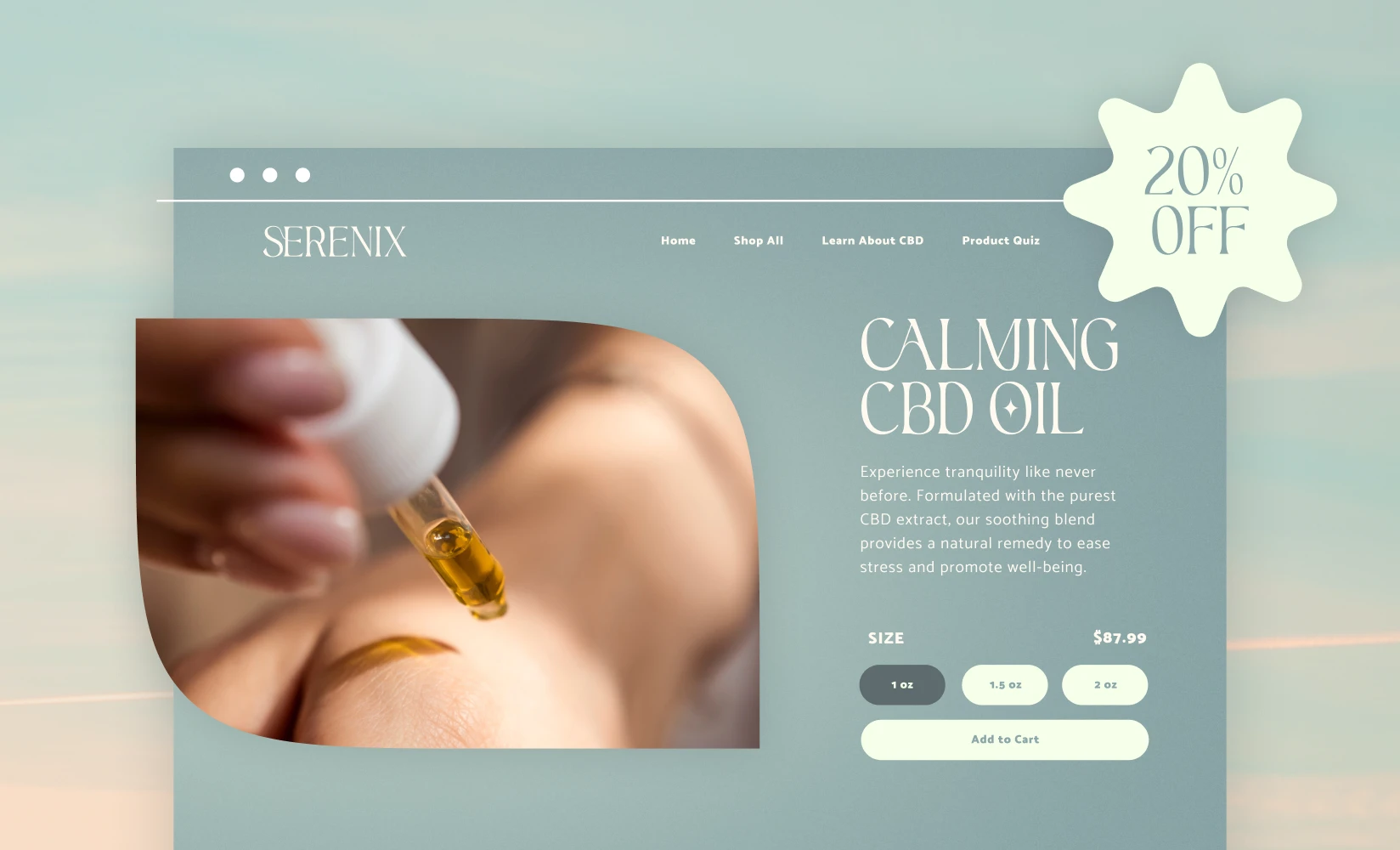
CBD marketing is a tricky and complicated affair.
While most traditional tactics used to grow an audience and close revenue (email marketing, social media growth, etc.) do work, they come with more than a handful of conditions.
The legalization of CBD is continuously changing. Advertising and social media platforms are a bit late to the party when allowing CBD brands to promote their products online.
If you’re marketing CBD products—be careful to color within the lines.
We’re here to help by exploring where CBD is and isn’t legal, the restrictions involved in marketing and advertising, and what you can and can’t say about your CBD products.
Then, we’ll delve into six powerful CBD marketing strategies designed to help grow your revenue without issues.
Table of Contents
#cta-visual-pb#<cta-title>Build high-converting product pages<cta-title>DIY your ecommerce product page design with the best drag-and-drop page builder for Shopify and BigCommerce.Start designing for free
The ins and outs of CBD marketing: What you can and can’t do

The first thing you need to know when marketing a CBD brand is that CBD marketing isn’t like marketing, say, an apparel brand or a meal subscription box.
Remember that CBD still isn’t legal everywhere (and might never be).
Even where it is legal for recreational use, there are many restrictions on what you can or can’t say or do about marketing and advertising campaigns.
Regulatory bodies, like the FDA (US’ Food and Drug Administration), enforce some restrictions.
The advertising platforms create other restrictions, further complicating things, as they change their guidelines on a whim.
Because it pays to be on top of your game regarding the legalities of marketing an online CBD store, let’s first explore what makes marketing CBD products unique.
Of course, the following is not legal advice, and we highly recommend engaging in local research (as rules, regulations, and restrictions differ across jurisdictions).
We’d also recommend staying current on the ever-changing laws and regulations surrounding CBD.
Where is CBD legal?
If CBD isn’t even legal in the country or state you’re trying to sell it in, your CBD marketing is dead in the water.
Notably, many CBD brands are looking to sell online to gain the ability to reach an international audience.
It’s critical to stay current on the state of legality—not only in your home region but in any location where you might sell and ship.
A snapshot of the global CBD landscape
Before diving in, let’s understand where you can and cannot sell CBD. Regulations constantly evolve, so knowing the current landscape is essential before making any big moves.
Countries with unrestricted CBD use, meaning you can sell CBD products used and marketed in the country without specific limitations or guidelines:
- United States (in some states)
- Canada
- Uruguay
- United Kingdom
- Bulgaria
- Netherlands
- Denmark
- Poland
- Romania
- France
- Germany
- Slovenia
- Greece
- Sweeden
- South Africa
- Hong Kong
- Japan
Countries with restricted CBD use restrict CBD sales under specific guidelines, such as THC limits or product-type regulations.
Merchants can sell here as long as they follow the rules closely:
- Panama
- Belize
- Argentina
- Brazil
- Chile
- Paraguay
- Peru
- Portugal
- Norway
- China
- Israel
- South Korea
- Turkey
- Thailand
- Australia
- New Zealand
Countries where CBD is banned, meaning it’s illegal to use, sell, or market CBD in any form:
- Cuba
- El Salvador
- Haiti
- Guatemala
- Nicaragua
- Bolivia
- Ecuador
- Guyana
- Venezuela
- Lithuania
- Slovakia
- Egypt
- Kenya
- Nigeria
- Singapore
- Vietnam
(Source: CBD Nerds)
Stay alert—CBD laws change fast. Always keep current on laws in your target markets. Adapt to changes, seize opportunities, and thrive as a savvy marketer.
Hemp-derived CBD: Your ticket to a broader market
No research about the legalities of CBD marketing is complete without an understanding of the difference between cannabis-derived and hemp-derived CBD, which has significant consequences on your ability to sell and market a given product.
The main difference between the two plants is the THC levels produced.

Hemp and cannabis are two different varieties of the same plant, but cannabis produces a whole lot more THC, though both contain CBD.
Here’s why that’s important.
The legal status of hemp-derived CBD products
The 2018 Farm Bill legalized hemp and allowed its use in hemp products under FDA regulation. This makes hemp-derived CBD federally legal, so long as the product has less than 0.3% THC.
And since hemp plants have more CBD and way less THC, it’s a win-win situation for CBD brands.
That’s why most CBD products are hemp-derived.
Though the 2018 Farm Bill legalized such products on a federal level, CBD product legality still depends on state laws, and it’s still up to each state to determine regulations around sales and distribution.
Additionally, some CBD products that contain more than 0.3% THC are still legally considered marijuana (and therefore are federally illegal), but under some state laws are now permitted.
State-specific regulations in the US
Here’s the current legal status of CBD in the United States (at the time of writing this):
| State | Legality of CBD |
|---|---|
| Alabama | Conditionally Legal |
| Alaska | Fully Legal |
| Arizona | Fully Legal |
| Arkansas | Conditionally Legal |
| California | Fully Legal |
| Colorado | Fully Legal |
| Connecticut | Fully Legal |
| Delaware | Conditionally Legal |
| District of Columbia | Fully Legal |
| Florida | Conditionally Legal |
| Georgia | Conditionally Legal |
| Hawaii | Conditionally Legal |
| Idaho | Conditionally Legal |
| Illinois | Fully Legal |
| Indiana | Conditionally Legal |
| Iowa | Conditionally Legal |
| Kansas | Conditionally Legal |
| Kentucky | Conditionally Legal |
| Louisiana | Conditionally Legal |
| Maine | Fully Legal |
| Maryland | Conditionally Legal |
| Massachusetts | Fully Legal |
| Michigan | Fully Legal |
| Minnesota | Conditionally Legal |
| Mississippi | Conditionally Legal |
| Missouri | Conditionally Legal |
| Montana | Fully Legal |
| Nebraska | Conditionally Legal |
| Nevada | Fully Legal |
| New Hampshire | Conditionally Legal |
| New Jersey | Fully Legal |
| New Mexico | Conditionally Legal |
| New York | Fully Legal |
| North Carolina | Conditionally Legal |
| North Dakota | Conditionally Legal |
| Ohio | Conditionally Legal |
| Oklahoma | Conditionally Legal |
| Oregon | Fully Legal |
| Pennsylvania | Conditionally Legal |
| Rhode Island | Conditionally Legal |
| South Carolina | Conditionally Legal |
| South Dakota | Conditionally Legal |
| Tennessee | Conditionally Legal |
| Texas | Conditionally Legal |
| Utah | Conditionally Legal |
| Vermont | Fully Legal |
| Virginia | Fully Legal |
| Washington | Fully Legal |
| West Virginia | Conditionally Legal |
| Wisconsin | Conditionally Legal |
| Wyoming | Conditionally Legal |
A brief reminder, though, that you should continuously monitor and follow state-specific regulations and updates on CBD legality, as the above is always subject to change.
What you can’t say in CBD marketing campaigns?
Staying within legal boundaries when making claims in CBD marketing materials is critical.
Sure, your hemp-derived CBD product with less than 0.3% THC might be legal, but that doesn’t mean you can say any old thing about it.
That said—this is true of most products. You can’t sell chocolate cakes and tell people they’ll lose 5 lbs!
There are limitations on what you can and can’t say in CBD marketing and promotional materials.
Make sure your marketing doesn’t make unproven claims or suggest off-label uses.
Health and medical claims
When marketing CBD products, brands must be cautious about making explicit health or medical claims. Specifically:
- Avoid direct health or medical claims: You can’t claim that your CBD product cures, treats, or prevents diseases or medical conditions. For instance, directly stating that a product “cures arthritis” or “treats anxiety disorders” would be prohibited.
- Be cautious with general wellness claims: Indicating potential benefits, like “helps with sleep” or “supports inflammation reduction,” is a gray area. If mentioned, use disclaimers and avoid definitive statements.
- Avoid associating with the medical world: This means no imagery of doctors, hospitals, or medical tools in your marketing materials.
CBD brands should follow these guidelines to build trust and distinguish themselves. For consumers, understanding these rules leads to informed choices.
In CBD marketing, brands aim to keep things clear and genuine.
As yet untested assumptions
You can’t make claims about untested assumptions. Additionally, test your assumptions before making claims.
So, don’t tell people to use your CBD product to treat any given condition as part of a particular medical routine or to replace a pharmaceutical product they’re already taking.
Calling CBD products food or dietary supplements
You can’t market your CBD products as food or dietary supplements. Also, you can’t add CBD to items classified as food or supplements by the FDA.
That’s why most CBD products are sold as oils or gummies.
Can you market CBD on social media?
Yes, you can market your CBD products on certain social media websites. However, it’s important to note that there is a difference between marketing and advertising:
- Marketing is posting organic content on your social media channels. This is widely accepted.
- Advertising is running paid ads to get in front of non-followers. This is more likely to be prohibited.
The following is the status quo as of writing (August 2023), but it’s critical to note that these platforms adjust their guidelines regularly.
We recommend regularly checking each platform’s CBD advertising and marketing policy before engaging in this activity.
Facebook and Instagram
Considering selling on Facebook or Instagram? Meta’s guidelines for this are pretty straightforward:
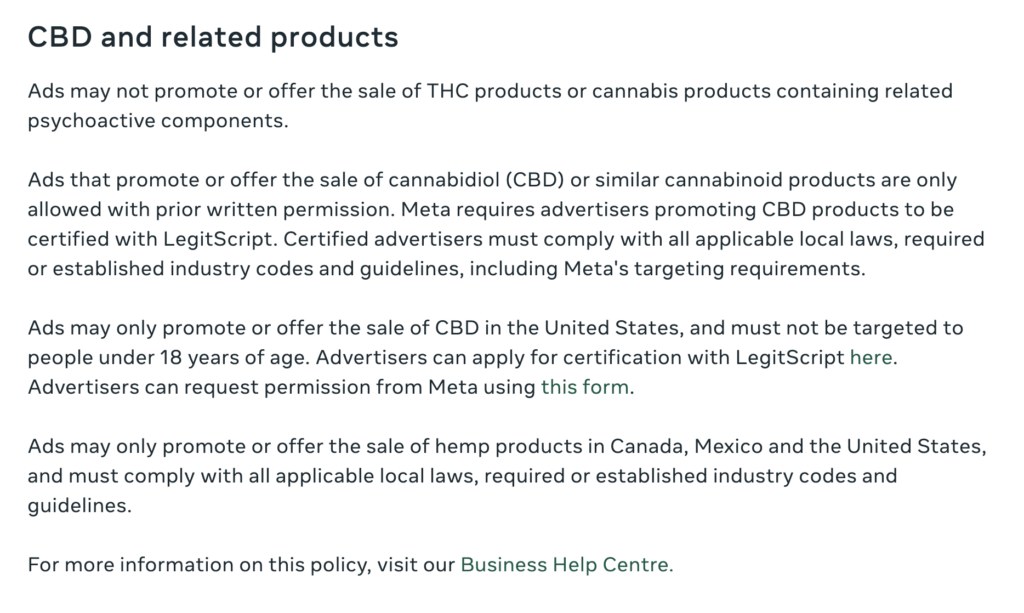
Basically, you can run ads on CBD products, not THC products, and you can only do so in the United States, provided you’re certified with LegitScript.
X (formerly Twitter)
The platform formerly known as Twitter recently updated its guidelines around advertising CBD products. Good news for brands—you can indeed advertise your CBD products on X, but there are some ground rules.
In short, you can market your products in the United States if you’re properly licensed, don’t target minors, and sell a hemp-derived topical product.

Since January 2023, Google has permitted CBD industry companies to advertise on their Adwords platform.
Here’s what Google says about marketing CBD products on its platforms:
- FDA-approved pharmaceuticals containing cannabidiol (CBD) and topical, hemp-derived CBD products with THC content of 0.3% or less in California, Colorado, and Puerto Rico are allowed.
- Every Google ad promoting other CBD-based products, including supplements, food additives, and inhalants, continues to be disallowed.
- In the United States, only topical CBD products certified by LegitScript can be promoted on Google.
It boils down to this—secure the proper certifications, target specific regions, and stay updated on product categories permitted. It’s a nuanced game, but being informed makes all the difference.
Navigating CBD marketing and advertising
So, with all of this information in mind, what’s the best way to market a CBD brand?
First, you must be aware that you’re in a fast-changing market. Google and X (formerly Twitter) have changed their advertising policies recently, and more and more countries and states are legalizing and approving different forms of marketing.
That’s excellent news: It gives you a bigger market to sell to and improves your ability to reach them via different marketing channels.
However, it could just as easily swing the other way, with regulations (particularly restrictions from social media platforms) evolving quickly.
So, our recommendation is two-fold:
1. Stay updated: Be on top of CBD marketing trends, especially if you’re engaging in advertising or marketing tactics on social media platforms.
2. Build a strong marketing foundation: Use social media marketing to supplement a strong foundation of evergreen marketing tactics, which should include:
- A high-converting website
- Educational and inbound content
- Customer reactivation and retention strategies
- Growing an organic social media following
A strategy like this serves as a foundation, letting you incorporate novel methods—like tapping into emerging trends or using new tech platforms—to drive growth.
Think of it as an 80/20 split: 80% rooted in evergreen tactics and 20% exploring fresh, innovative strategies to catch your audience’s attention.
6 Robust long-term CBD marketing strategies
Incorporating the following six strategies into your CBD marketing approach will help you build a long-term engine for brand and revenue growth.
1. Build a streamlined online shopping experience
The foundation of every marketing campaign you run is your website, especially if you’re selling online.
It’s where potential customers learn about your brand and products, where they buy your stuff, and where all of your marketing activities—be they ads, organic content, or email campaigns—direct buyers.
This should be your first port of call for maximizing CBD sales.
Here are a few ways to improve the online shopping experience to improve conversion.
Keep the design clean and simple
A clean, modern, and simplistic (or at least uncomplicated) design is generally the best fit, like this design from HempLucid:
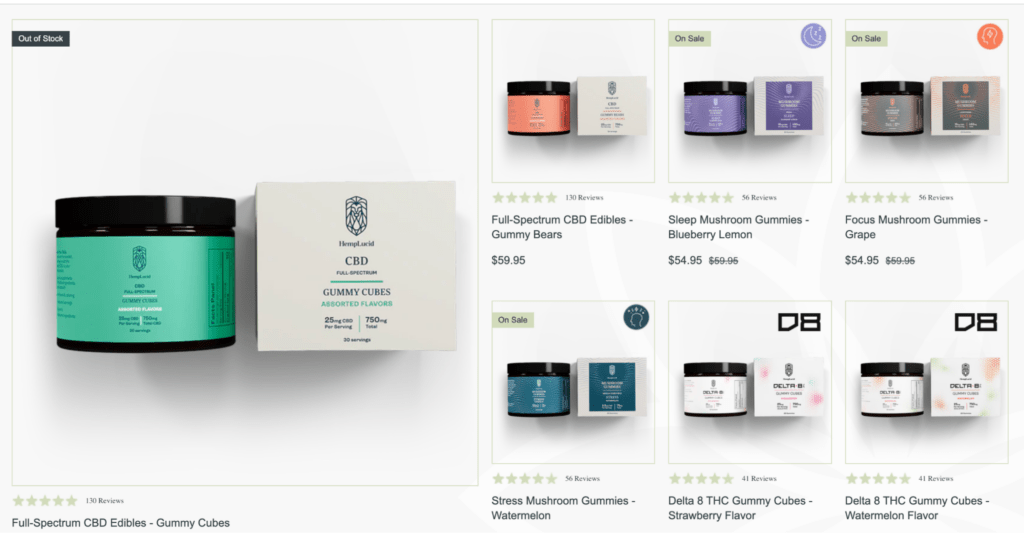
If your site is on Shopify, one of their free themes is a great place to start to avoid getting overly complicated.
Make site edits and additions fast and easy
From there, an intuitive tool like Shogun Page Builder can help you design stunning product pages without needing advanced coding knowledge or waiting on a developer.
Advanced features like AI Text, AI Elements, Global Snippets, and pre-built drag-and-drop blocks and elements give you the flexibility to design engaging customer experiences while keeping your site clean, fresh, and quick to navigate.
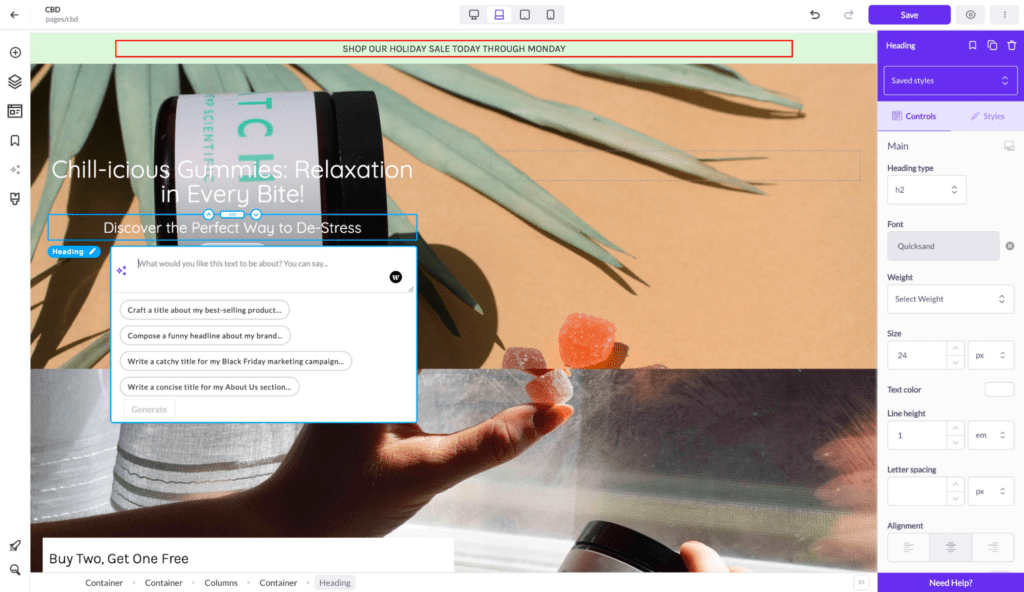
Speaking of navigation…
#cta-visual-pb#<cta-title>Build custom product pages<cta-title>Use Shogun Page Builder to drive intrigue and maximize conversion on your CBD store—all without coding. Start building for free. Start building for free
Focus on helpful navigation cues
Think about the customer shopping experience, and design your categories and top navigation bar around that.
In Shopify, your collections are the perfect vehicles for excellent navigation.
With Shopify collections, you can create categories of products (for instance, oils) to help users navigate your site more easily. You can even create more niche collections, like ‘Gifts for Dad’ to get more specific for your campaigns.
Consider how customers typically browse for CBD products and organize your store around that.
For instance, do they come in knowing they’re looking for oil, not gummies? Or are they more interested in narrowing down to their desired dosages first?
For CBD LION customers, it’s the former, so they’ve structured their product menu as such:

Get your product imagery sorted
High-quality product imagery is vital because it looks good and builds trust, showcases your product’s features, and can significantly influence purchasing decisions.
This applies to both the products you sell and the packaging they come in. To take it a step further, consider creating product videos.
Video offers a more immersive online shopping experience, allowing customers to get closer to an in-store experience from the comfort of their homes.
Design a hassle-free checkout experience
Once a customer reaches the point of checkout, you don’t want them jumping through a bunch of additional hoops. Make checkout super simple.
So, you can:
- Minimize the pages and clicks a customer has to go through to pay
- Allow them to auto-fill details like their delivery address
- Include multiple options for payment to facilitate different cards and pre-saved details
2. Attract inbound leads with helpful content
Even if you can’t advertise CBD on some big platforms, people can still find you through regular online searches. For instance, when you search “CBD coffee,” these brands pop up:
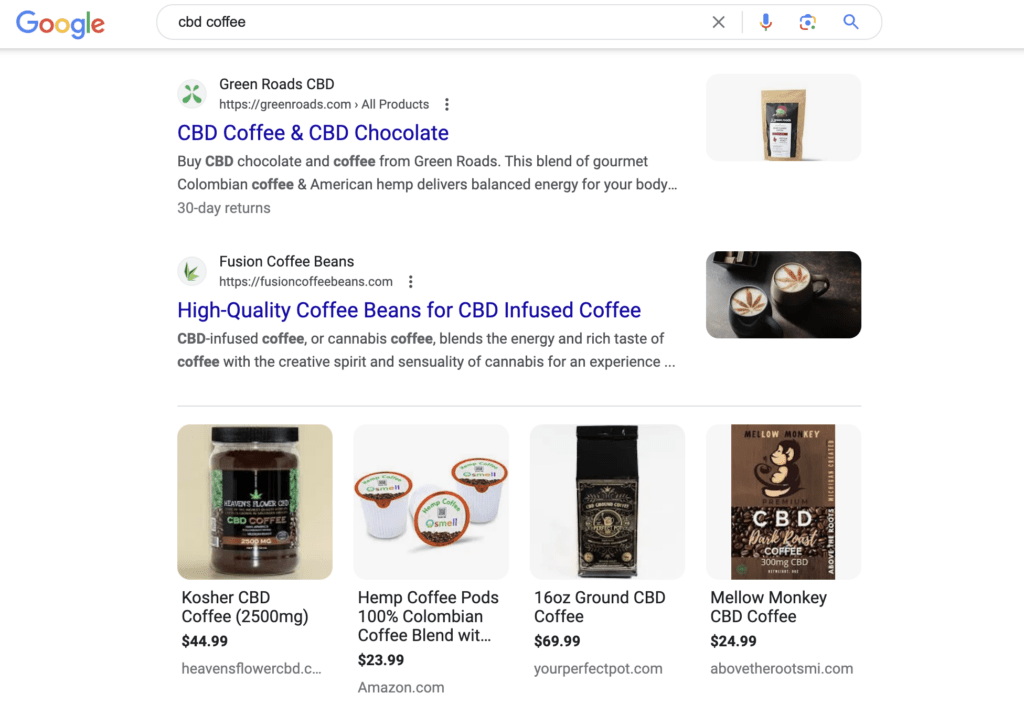
To show up in the SERP like this, you must focus on ecommerce content marketing. Content, particularly SEO-focused, achieves two goals:
- Drives inbound leads to your business via search traffic
- Helps position your brand as an authority and an industry expert
Here’s what you need to do to leverage this marketing channel.
Optimize existing pages for search
First, you want to optimize the product pages you already have on your site.
Make sure that:
- Your page design is clean and loads quickly (slow load times are an SEO detractor)
- Your product URLs include the keyword your page is targeting
- Your product descriptions are optimized and include your target keyword
- Your internal pages link naturally to one another
Create an SEO content plan
Next, consider leveraging your blog content and keyword-focused landing pages to increase and expand your reach through search.
An effective SEO strategy for your brand might look like:
- Building a series of landing pages focused on important brand-related keywords (e.g., high-dosage CBD gummies)
- Designing a blog content calendar to capture search traffic closer to the top of the funnel
- Investing in a local SEO strategy (for instance, CBD oil Seattle)
Go beyond blogs
While marketing CBD, you’re selling a product and educating a curious public. Here’s how each content type can be effectively utilized for CBD marketing:
- Whitepapers help present complex CBD studies and data in a digestible format, positioning your brand as an informed leader. Use these to explain topics like CBD’s effects on specific health issues or the difference between full-spectrum and isolate CBD.
- A buyer guide helps newcomers understand product types, dosages, or legal aspects. A guide might help consumers differentiate between quality CBD oils or recommend dosages for varied needs.
- Podcasts interview experts to discuss CBD’s therapeutic properties, share user testimonials, or discuss legislative changes. Episodes can range from medical discussions to personal CBD success stories.
For inspiration, check out HempLucid, which offers free video-based education on its website.
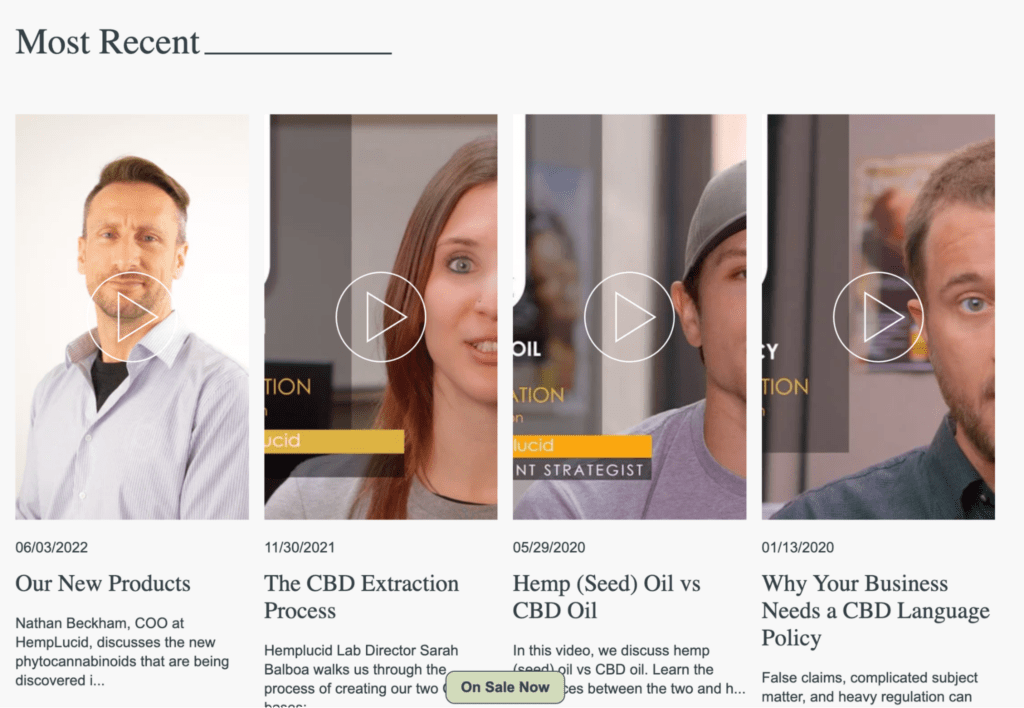
3. Leverage existing audiences
By tapping into existing audiences, you can boost your reach quickly and maximize your return on investment.
Here are three powerful channels you can use that come with built-in audiences.
Affiliate marketing
Affiliate marketing is when another person, company, or website recommends your product, directs traffic back to your site, and earns a commission for each sale made through their referral.
For instance, launching an affiliate marketing program can encourage a blogger or a niche product review website to feature one of your products in their “top CBD brands” list, helping you tap into their readership and acquire new potential customers.
Influencer marketing
Influencer marketing is similar, except that you’re directly paying someone with a captive audience (like a social media following) to promote, recommend, or even advertise your product on their channels.

Social media groups
Platforms like Facebook, Reddit, and Discord host various interest groups where like-minded individuals gather.
For instance, on Reddit, the “r/CBD” subreddit is a thriving community where users discuss CBD benefits, uses, experiences, and more.

Engaging in such communities can be a valuable way to interact with potential customers, answer queries, offer advice, and position your company as a trusted source.
4. Optimize your email marketing campaigns
Building your captive audience (like an email list) as a CBD brand takes a lot of work due to the previously discussed advertising restrictions.
Once you’ve got one, you want to make the most of it. Plus, email marketing is super cost-effective, so it’s kind of a no-brainer.
That said, you don’t want to become one of those spammy brands sending promotional emails every other day.
Here are a few strategies for ecommerce email campaigns that your audience will want to open.
Personalized discount codes
Discount codes are always a classic and effective way to encourage additional purchases.

Double down on their impact by making your offers as personalized as possible.
For instance, you can automate birthday offers with personalized codes (like your customer’s name) or do the same on the anniversary of a customer’s first purchase.
Replenishment offers
Carefully timed replenishment offers are another great way to personalize email communications.
For instance, a given customer purchases an oil from your store that typically lasts three months.
Once ten weeks have passed since delivery, you send an automated email reminding them that their stash is about to run out—along with a personalized 10% discount code.
Back-in-stock alert
Rather than removing out-of-stock products from your store, leave them online for customers to browse and provide options to sign up for notifications.
Then, when you’ve replenished your suppliers, you can send out a restock alert to an audience you know is interested.
5. Make contextual product recommendations
Product recommendations are a powerful tool to boost revenue. They’re not just about showcasing other items but understanding your customer’s journey and enhancing their shopping experience.
Let’s break it down a bit:
- Upselling: Offer a higher-concentration or premium option. For instance, suggest a 750mg CBD oil to someone looking at a 500mg variant. Another effective upsell tactic is introducing subscription programs: “Enjoy 10% off when you subscribe monthly!”
- Cross-selling: Recommend complementary products. Someone buying CBD oil might also enjoy a calming CBD tea to go along with it.
- Bundling: Group products together at a discount. For a reduced price, offer a package deal with CBD balm, tincture, and gummies.
Amazon has perfected the art of contextual recommendations, but you don’t need to be an ecommerce giant to get it right.
By understanding your customers and the synergies between your products, you can get their attention and guide them towards choices that enhance their experience—and your bottom line.
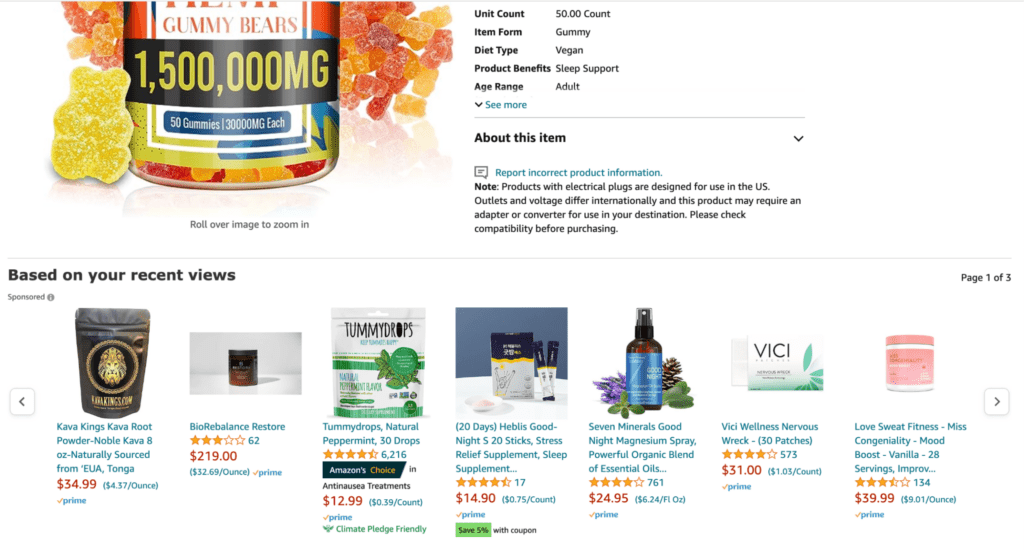
6. Focus on customer retention
Broadly speaking, selling to existing customers is better than acquiring new ones.
Returning customers tend to check out with larger carts, cost less to convert, and are more likely to recommend your brand to others.
However, customer retention strategies are critical in CBD marketing, where advertising to new customers is a bit more complicated.
Sure, if your product is excellent, people will return, but there’s a difference between “loyal” and “return” customers.
Return customers buy more than once but might consider alternatives. Loyal customers wouldn’t even think of shopping around.
You want to create loyal customers, so you should start by building a loyalty program.
Loyalty programs incentivize buyers to purchase more often by rewarding them with bonus gifts or points they can stack up to use as discounts later.
Check out how HempLucid encourages new customers to sign up for their loyalty program at checkout:
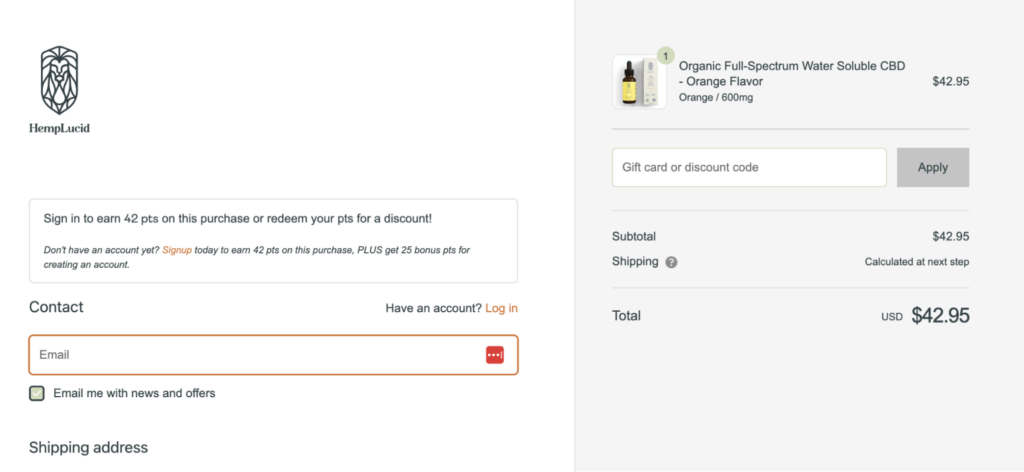
Then, set up an automated email campaign to convert first-time buyers into repeat customers.
Send a personalized discount code carefully timed to arrive right after the customer gets their first shipment.
Each strategy discussed above is effective in isolation but works even better together.
Prioritize based on your needs and goals, but incorporate as many as possible for a more holistic customer experience.
Take your CBD marketing efforts to the next level
Due to a range of restrictions, regulations, and legal gray areas, CBD marketing is tricky but possible.
Maintaining a robust, evergreen marketing strategy is vital for ecommerce managers and merchandisers. It helps to create a dedicated audience and drive sales effectively.
The bonus? Not being tied to the whims of advertising platforms and their constantly changing community guidelines. Quite the advantage, wouldn’t you say?
Here’s what to focus on:
- A website designed for optimal conversions
- Educational and inbound content
- Leveraging others’ existing audience
- Customer retention and reactivation
One final reminder before we take off:
The landscape of CBD marketing continues to change, and marketers in this industry have to stay informed about new developments, changes to advertising, marketing guidelines, and local legal restrictions.
#cta-visual-pb#<cta-title>Build beautiful Shopify product pages<cta-title>DIY your ecommerce product page design with the best drag-and-drop page builder for Shopify.Start designing for free

Leigha Henderson
Leigha is a content marketing specialist and content creator. She found her path through a love of research, strategy, data, and the written word. (And skiing. She also loves skiing.)



